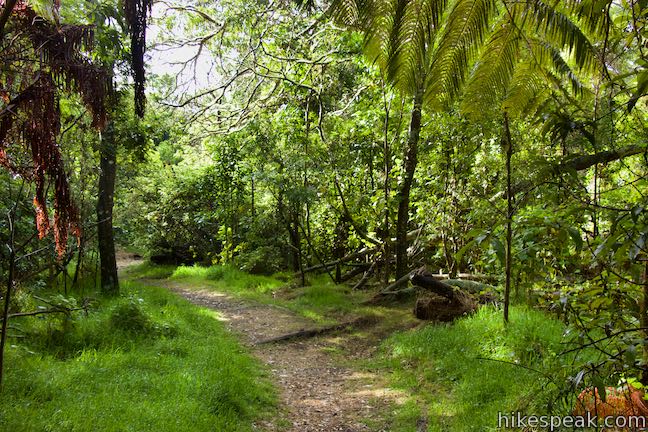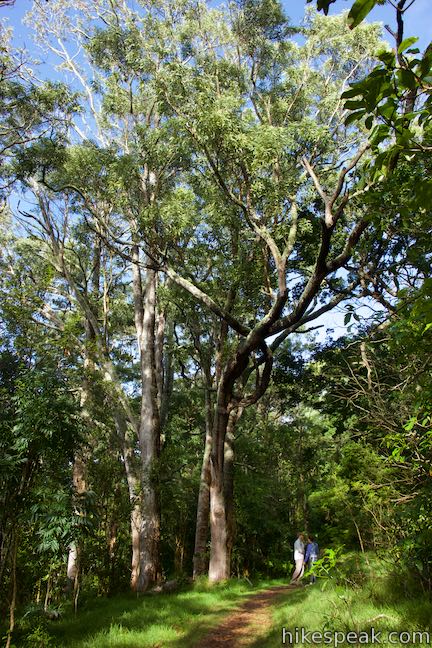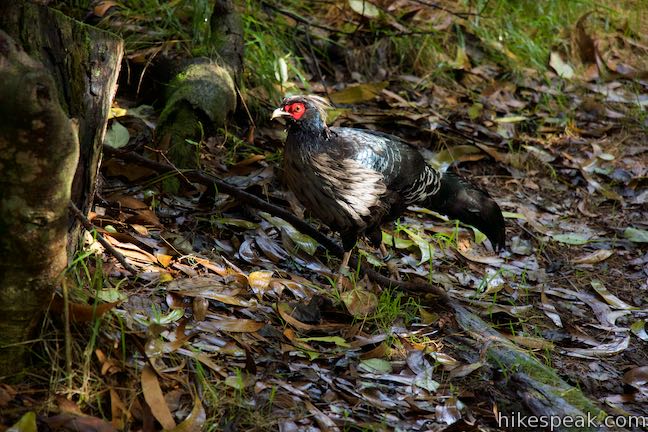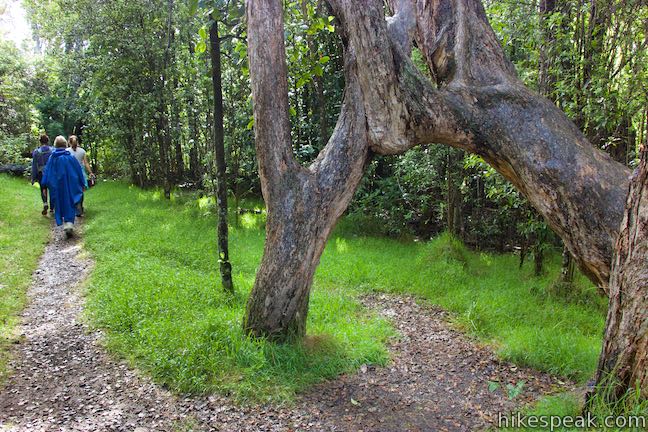Kīpukapuaulu Trail
in Hawai‘i Volcanoes National Park

Filled with bold volcanic features and landscapes reinvented by eruptions, Hawaiʻi Volcanoes National Park might seem an unlikely place to find a deep-rooted forest packed with plant diversity and a thriving bird population. Kīpukapuaulu rises like an oasis, framed the less-fertile lands forged by more recent lava flows.
Kīpukapuaulu Trail is a 1.2-mile long nature trail loop with 185 feet of elevation change that explores a Special Ecological Area in Hawaiʻi Volcanoes National Park. This hike can last twenty minutes or two hours, depending on how much you want to read. The 28-page brochure for the nature trail has eleven entries linked to numbered markers along the route – and lots of information to digest. Over twenty additional panels along the route identify some of the mostly-native trees, shrubs, and smaller plants growing along the route. Take a hike and get to know the forest!
The name Kīpukapuaulu comes from three Hawaiian words. Kīpuka is a unique Hawaiian word that means “island of ancient vegetation surrounded by a sea of younger lava flows.” Pua means “flower” and ulu means “growing.” Kīpukapuaulu is an oasis within the lava flows where plants thrive.
Start from a parking area on Mauna Loa Road, 4 miles from the entrance of Hawaiʻi Volcanoes National Park (and 2 miles from the nearby Tree Molds Site). The trail starts in a shrubby area outside the forest itself. Enjoy an extra dose of sunlight as you walk 120 yards up the single-track trail to the edge of the forest and the beginning of the loop. A marker with the number 1 and an arrow to the left suggest that you hike the loop in a clockwise direction. Crack open the trail guide and read as you go.

Turn left at the start of the loop in Kīpukapuaulu Trail. You won’t hit a junction again until the end of the loop, so enjoy this forest walk and soak it all in.
As described in a panel at the trailhead, Kīpukapuaulu is one of Hawai‘i’s richest forests – certainly in this area of the Big Island – with more native tree species per acre than any other forest in Hawai‘i Volcanoes National Park. The healthy state of Kīpukapuaulu today came from good stewardship over the last century, preceded by a period of neglect:
Envision this forest teeming with life. The songs of ʻōʻū (a parrot-billed honeycreeper) and ʻalalā (Hawaiian crow) filled the canopy. Native plants and insects thrived. Centuries of undisturbed isolation allowed its native residents the freedom to diversify into myriad specialized species. Early Hawaiians visited often and gave this forest its name, Kīpukapuaulu – the forest of flourishing life.
Early Hawaiians treated Kīpukapuaulu like a sacred place. Unfortunately, the people who came to Hawaii in the 1800s did not hold the forest with the same regard:
Introduced species devastated this once thriving, untouched, native forest. Cattle and goats ravaged understory plants to the point of extinction. They left behind a sea of invasive grasses. Only tall trees remained. With the arrival of rats, mongooses, pigs, and mosquitoes, native bird populations were decimated. Species richness and diversity plummeted.
Conservationist stepped in and stemmed the destruction, protecting the forest and plotting its recovery. Kīpukapuaulu has proved to be a resilient forest – still considered by native Hawaiians to be a home for the gods – home to distinct Hawaiian plants and animals.
Prepare for several starts and stops in the hike as you break to read from the guide. The first three markers for the guide entries come in the first 250 yards and the rest of the markers come in steady intervals, popping up about every tenth of a mile.
The trail also hosts small panels identifying and describing some of the interesting plants along the trail. Many native plants have unique qualities, like the māmaki, which has “nettleless nettles” that do not sting. Hawai‘i did not have grazing animals that needed to be fended off with nettles, so the māmaki evolved without them. Similarly welcoming are the ‘akala, Hawaiian raspberries, which are prickerless or nearly-prickerless and can grow berries as large as golf balls. Other highlighted plants include: ‘ala‘ala wai nui, ‘a‘ali‘i, hāpu‘u pulu, hau kuahiwi, hōlei, hō‘awa, koa, kōlea lu nui, kōpiko ‘ula, kupukupu, māmane, maua, meadow ricegrass, ‘ōhi‘a lehua, olopua, palapalai, pāpala kēpau, pilo, and pūkiawe.
The trail goes gradually uphill. Koa trees and mānele tree stand tall along the trail, offering a shaded canopy. The biggest trees survived the forest-grazing era (error). Look up, down, and all around as you hike up Kīpukapuaulu Trail.

After 0.45 miles of hiking, spot the sixth numbered marker. A path off the right side of the trail strays a couple yards over to the opening of a lava tube that is just below the forest. (You are in Hawaiʻi Volcanoes National Park after all!) Walk over to see the lava tube, but don’t venture inside. The trail guide explains:
Under this lush forest lies a foundation—a body of pāhoehoe lava overlain with centuries of volcanic ash. Formed within the body of pāhoehoe lava flows are lava tubes—volcanic caves that were once filled with molten lava. This lava tube is at least 8,600 years old. While active, it once transported lava over great distances, from its eruptive source to its most distal reaches. Skylights are holes in a lava tubes roof where the ceiling has collapsed, leaving an opening like the one we see here. This lava tube was formed during one of Mauna Loa’s many eruptions.
The park asks that visitors do not enter the lava tube along Kīpukapuaulu, and with good reason. The lava tube is recovering from previous human damage and is home to some uniquely adapted cave animals and plants. The surrounding forest evolved in isolation, which is doubley true for the lava tube:
It was in this lava tube, in 1971, that the first cave-adapted animal species in Hawai‘i, was discovered. One such species unique to these dark and often damp lava tubes includes the small-eyed, big-eyed hunting spider (Lycosa howarthi). This endemic spider, along with other insects like the millipedes (Nannolene) and the lava tree crickets (Thau athgryllus cavicola), continue to call this fragile lava tube home.
Follow the trail up around the north side of the loop, which is also the high end of the hike by elevation. Pass the first of two benches as the trail crests. Don’t be surprised if you see large birds sharing the trail or foraging in the surrounding forest. Kalij pheasants were introduced in the area in the 1960s. Kīpukapuaulu is also referred to as a bird park.

The second half of the loop is downhill. Weave through more forest accompanied by botany lessons. At 3/4 of a mile from the start of the hike, pass a fun feature on the right side of the trail where thick tree limbs and trunks come together about seven feet off the ground to form an arch that you can walk right under.

The trail passes a second bench, which hosts the marker for the ninth entry in the trail guide. This entry describes how, before it was protected the National Park Service in 1916, this forest was owned by a cattle ranch and a koa harvesting company. During its restoration, the Civilian Conservation Corps built this trail through the forest in 1934.
Continue along the tropical forest past fern trees and ferns on the ground. The forest thins as you close out the loop. Return to the junction where you made the initial left. Turn left again to venture back to the trailhead.
No permit is required to hike Kīpukapuaulu Trail. An entrance fee is charged to access Hawaiʻi Volcanoes National Park (although this trailhead can be reached without passing through the entrance station). Dogs, bikes, and horses are prohibited.
To get to the trailhead: Take Hawaii Belt Road (Route 11) to Mauna Loa Road, located 2.3 miles east of the main entrance of Hawaii Volcanoes National Park (which is 30 miles south of Hilo). Mauna Loa Road will be on the right when traveling from Hilo.
Turn up Mauna Loa Road. Drive straight past Tree Molds Road on the right, leading to the Tree Molds. Go 1.5 miles up Mauna Loa Road in all, passing a day use picnic area on the right just before a circle in the road with a parking area on the right for Kīpukapuaulu Trail where the hike begins.
Trailhead address: Bird Park, Mauna Loa Road, Hawaii Volcanoes National Park, HI 96785
Trailhead coordinates: 19.4375, -155.3032 (19° 26′ 15″N 155° 18′ 11.5″W)
View Hawai‘i Volcanoes National Park in a larger map
Or view a regional map of surrounding Hawaii trails and campgrounds.
 | Sulphur Banks Trail - Crater Rim Trail Loop This 1.6-mile hike starting from Kīlauea Visitor Center tours a colorful hydrothermal area and looks into Kīlauea Caldera from Steaming Bluff. |
 | Keanakāko‘i Crater & Overlook Trail This 2.15-mile hike follows eruption-damaged Crater Rim Drive to views into Keanakako'i Crater and the far grander Kilauea Summit. |
 | Pu‘u Loa Petroglyphs Trail This 1.4-mile hike in Hawai‘i Volcanoes National Park traverses an old lava flow to a boardwalk loop within a special area of preserved petroglyphs. |
 | Hōlei Sea Arch This brief hike in Hawai‘i Volcanoes National Park crosses a basalt bluff to a landmark sea arch extending into the ocean. |
 | Rainbow Falls This 0.2-mile hike around Rainbow Falls Lookout explores a viewpoint facing a lovely waterfall and also ventures up to the top of the falls. |
 | Kaumana Caves This underground hike explores lava tubes on the edge of Hilo, created by an 1881 eruption of Mauna Loa. |
 | ‘Akaka Falls This short loop slips through a tropical valley to bold views of a 442-foot single-drop waterfall. |
 | Royal Grounds – Pu‘uhonua Loop This half-mile loop on the coast south of Kona explores Hawaiian royal grounds and a place of sanctuary in Pu‘uhonua O Hōnaunau National Historical Park. |
 | Trails in Hawaii Explore more hikes on the Big Island of Hawai‘i. |












































Go the extra miles...
Submit a rating of this hike to go with your comment. Contribute to the average trail rating.